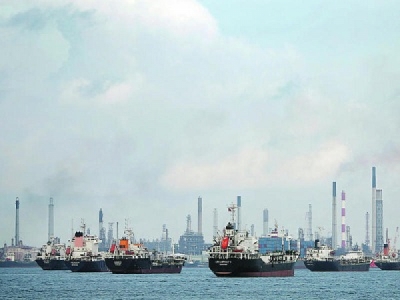
Posted on April 26, 2018
By Kenneth Cheng, Today Online
More than three years after work on the first phase of the mega Tuas Terminal began, the authorities have awarded a billion-dollar reclamation project for the next phase to a joint venture made up of contractors from Japan, South Korea and the Netherlands.
A consortium comprising Japan’s Penta-Ocean Construction Company, South Korea’s Hyundai Engineering & Construction Company and the Netherlands-based Boskalis International has bagged the S$1.46 billion project, the Maritime and Port Authority of Singapore (MPA) announced on Wednesday (April 25).
Works on the first phase, which began in February 2015, were awarded to a joint venture comprising Belgium’s Dredging International Asia Pacific, and Daelim from South Korea.
The first phase, which involves dredging the waters, constructing wharves and reclaiming 294 hectares of land, is set to be completed by the early 2020s.
As of last month, more than 70 per cent of the 221 caissons — watertight retaining structures — had been installed to form the wharves.
The second phase of the mega development — which spans four phases — will see the Tuas Basin being dredged, wharf structures erected and 387 hectares of land reclaimed.
When ready in the mid-2020s, the 21 deep-water berths in this phase can handle about 21 million twenty-foot equivalent units (TEUs) yearly. TEU is a measure of a container terminal’s capacity.
The Tuas Terminal, set to be completed in the 2040s, will have a total capacity of up to 65 million TEUs.
The MPA said the scale and complexity of the project — which is part of the Republic’s efforts to consolidate its port activities in Tuas — gave the authority as well as local and international engineers and contractors the opportunity to not only challenge themselves, but also find innovative solutions to maximise productivity and efficiency.
One challenge is in constructing the wharf structure, which will see engineers use an innovative design to fabricate some of the largest caissons worldwide on site, said the MPA.
Banking on caissons is more efficient than other methods such as piling, and it also affords crew a safer work environment. “As the caissons are of standard sizes and pre-fabricated in a factory-like environment on site, productivity and quality of the wharf structures will be improved,” the MPA added.
The deal was among seven agreements announced on Wednesday at the two-day Singapore Maritime Technology Conference at Marina Bay Sands.
The other agreements include the MPA’s partnership with Keppel Offshore and Marine, and the Technology Centre for Offshore and Marine Singapore to develop autonomous vessels capable of carrying out harbour operations, such as berthing and mooring.
The MPA also awarded the Maritime Innovation and Technology Fund to Singapore Technologies (ST) Electronics, the electronics arm of government-linked group ST Engineering, and Norway’s Kongsberg Norcontrol to develop a next-generation vessel traffic management system innovation programme. The consortium will invest up to S$9.9 million over three years to develop capabilities, including new decision-support tools such as those that analyse vessel routes, predict traffic hotspots and detect potential collision situations.
Source: Today Online





